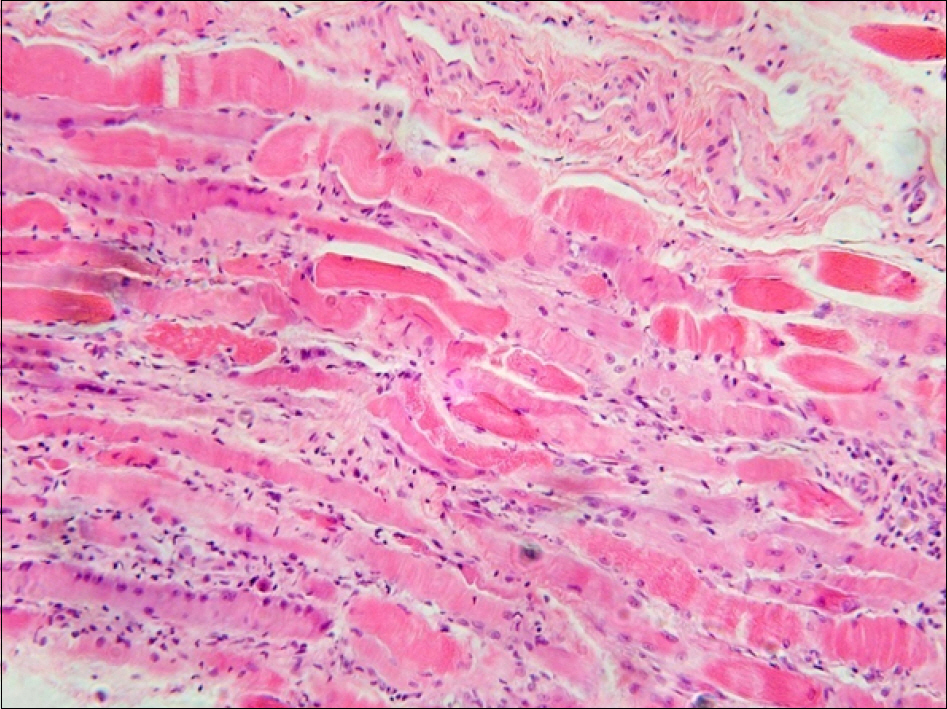J Rheum Dis.
2014 Feb;21(1):25-29. 10.4078/jrd.2014.21.1.25.
Acute Polymyositis/systemic Lupus Erythematosus Overlap Syndrome with Severe Subcutaneous Edema and Interstitial Lung Disease
- Affiliations
-
- 1Department of Rheumatology, Ajou University School of Medicine, Suwon, Korea. nakhada@ajou.ac.kr
- 2Department of Radiology, Ajou University School of Medicine, Suwon, Korea.
- 3Department of Pathology, Ajou University School of Medicine, Suwon, Korea.
- KMID: 2222985
- DOI: http://doi.org/10.4078/jrd.2014.21.1.25
Abstract
- Inflammatory myopathy is characterized by symmetrical proximal muscle weakness, elevated muscle enzyme levels and favorable response to glucocorticoids therapy. Although periorbital edema is a common manifestation of inflammatory myopathy, generalized subcutaneous edema is very rare. We report here a case of a 47-year-old female patient with acute polymyositis/systemic lupus erythematosus overlap syndrome with generalized subcutaneous edema and interstitial lung disease. We aggressively treated the disease with high-dose glucocorticoids, intravenous immunoglobulin, and immunosuppressive agents.
MeSH Terms
Figure
Reference
-
References
1. Miller FW. New approaches to the assessment and treatment of the idiopathic inflammatory myopathies. Ann Rheum Dis. 2012; 71(Suppl 2):i82–5.
Article2. Dimachkie MM. Idiopathic inflammatory myopathies. J Neuroimmunol. 2011; 231:32–42.
Article3. Jung KD, Kim PS, Park HY, Kim CR, Byun JY, Lee DY, et al. Dermatomyositis associated with generalized subcutaneous edema and Evans syndrome. J Am Acad Dermatol. 2012; 66:144–7.
Article4. Lee KH, Lim SR, Kim YJ, Lee KJ, Myung DS, Jeong HC, et al. Acute dermatomyositis associated with generalized subcutaneous edema. Rheumatol Int. 2008; 28:797–800.
Article5. Werner de Castro GR, Appenzeller S, Bértolo MB, Costallat LT. Acute dermatomyositis with subcutaneous generalized edema. Clin Rheumatol. 2006; 25:898–900.
Article6. Mroué KH, Sharara NH, Rbeiz JG, Arayssi TK. A case of edematous dermatomyositis. J Rheumatol. 2003; 30:2722–3.7. Gorelik O, Almoznino-Sarafian D, Alon I, Rapoport MJ, Goltsman G, Herbert M, et al. Acute inflammatory myopathy with severe subcutaneous edema, a new variant? Report of two cases and review of the literature. Rheumatol Int. 2001; 20:163–6.8. Smyth AE, Bell AL, Crone M. Acute oedematous dermatomyositis. Ann Rheum Dis. 2000; 59:575.
Article9. Nitsche A, San Agustín PG, Amado V, Prina AP, Corsaro G. Trunk and abdominal wall edema in dermatomyositis. Medicina (B Aires). 1988; 48:331–2.10. Lyon-Caen O, Bouche P, Chaunu MP, Duyckaerts C, Vitoux JF. Acute polymyositis with spontaneously re-gressive subcutaneous edema. Apropos of a case. Rev Neurol (Paris). 1985; 141:749–52.11. Andonopoulos AP, Gogos CA, Tzanakakis G. Subcutaneous edema: an "unrecognized" feature of acute polymyositis. Rheumatol Int. 1993; 13:159–61.
Article12. Venables GS, Bates D, Cartlidge NE, Hudgson P. Acute polymyositis with subcutaneous oedema. J Neurol Sci. 1982; 55:161–4.
Article13. Haroon M, Eltahir A, Harney S. Generalized subcutaneous edema as a rare manifestation of dermatomyositis: clinical lesson from a rare feature. J Clin Rheumatol. 2011; 17:135–7.14. Koler RA, Montemarano A. Dermatomyositis. Am Fam Physician. 2001; 64:1565–72.15. Castro C, Gourley M. Diagnosis and treatment of inflammatory myopathy: issues and management. Ther Adv Musculoskelet Dis. 2012; 4:111–20.
Article
- Full Text Links
- Actions
-
Cited
- CITED
-
- Close
- Share
- Similar articles
-
- A Case of Overlap Syndrome with Rheumatoid Arthritis and Polymyositis
- Three Cases of Overlap Syndrome Consisting of Systemic Sclerosis and Rheumatoid Arthritis
- Systemic lupus erythematosus accompanied with idiopathic inflammatory myopathy: report of 2 cases
- A Case of Overlap Syndrome with Systemic Sclerosis and Rheumatoid Arthritis
- A Case of Diffuse Alveolar Hemorrhage Associated with Overlap syndrome





